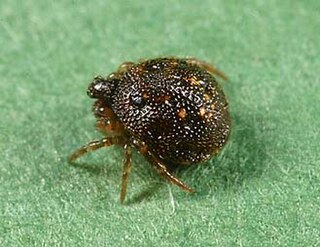
Tortoises are reptile species of the family Testudinidae of the order Testudines. They are particularly distinguished from other turtles by being land-dwelling, while many other turtle species are at least partly aquatic. Like other turtles, tortoises have a shell to protect from predation and other threats. The shell in tortoises is generally hard, and like other members of the suborder Cryptodira, they retract their necks and heads directly backwards into the shell to protect them.

The marginated tortoise is a species of tortoise in the family Testudinidae. The species is endemic to Greece, Italy, and the Balkans in Southern Europe. It is the largest European tortoise. The marginated tortoise is herbivorous, and hibernates for the winter.

The Greek tortoise, also known commonly as the spur-thighed tortoise, is a species of tortoise in the family Testudinidae. Testudo graeca is one of five species of Mediterranean tortoises. The other four species are Hermann's tortoise, the Egyptian tortoise, the marginated tortoise, and the Russian tortoise. The Greek tortoise is a very long-lived animal, achieving a lifespan upwards of 125 years, with some unverified reports up to 200 years.

Hermann's tortoise is a species in the genus Testudo. Two subspecies are known: the western Hermann's tortoise and the eastern Hermann's tortoise. Sometimes mentioned as a subspecies, T. h. peleponnesica is not yet confirmed to be genetically different from T. h. boettgeri.

The Russian tortoise, also commonly known as the Afghan tortoise, the Central Asian tortoise, Horsfield's tortoise, four-clawed tortoise, and the (Russian) steppe tortoise, is a threatened species of tortoise in the family Testudinidae. The species is endemic to Central Asia. Human activities in its native habitat contribute to its threatened status.

Testudo, the Mediterranean tortoises, are a genus of tortoises found in North Africa, Western Asia, and Europe. Several species are under threat in the wild, mainly from habitat destruction.

Aldabrachelys is the recognised genus for the Seychelles and Madagascan radiations of giant tortoises, including the Aldabra giant tortoise.

The Galápagos tortoise complex or Galápagos giant tortoise complex are the largest living species of tortoise. Modern Galápagos tortoises can weigh up to 417 kg (919 lb). Today, giant tortoises exist on only two remote archipelagos: the Galápagos Islands about 1,000 km (620 mi) due west of mainland Ecuador; and Aldabrachelys gigantea of Aldabra in the Indian Ocean, 700 km (430 mi) east of Tanzania.

Kleinmann's tortoise, also called commonly the Egyptian tortoise, Leith's tortoise, and the Negev tortoise, is a critically endangered species of neck-hiding tortoise in the family Testudinidae. The species is native to Egypt and Libya. The species was once more widespread, but its numbers are now dwindling. The species is nearly extinct in Egypt, and complete extinction in the wild is a looming threat unless more actions are taken to protect this species.

Hesperotestudo is an extinct genus of tortoise that lived from the Miocene to the Pleistocene. Its remains are known from North America, Central America and Bermuda. Further specimens identifiable only to genus have been found in El Salvador.
Terrestris, terrestrial in Latin, is a species name present in a number of species Latin names:
Phoroncidia nasuta, is a species of spider of the genus Phoroncidia. It is found in Japan, Sri Lanka and Taiwan. The spider is known as Hana Naga poke Ne spider (トウキョウカブトヒメグモ) in Japan.

Phoroncidia is a genus of comb-footed spiders that was first described by J. O. Westwood in 1835.
Phoroncidia septemaculeata, is a species of spider of the genus Phoroncidia. It is found in Sri Lanka and India.
Phoroncidia thwaitesi, is a species of spider of the genus Phoroncidia. It is endemic to Sri Lanka.
Brunepisinus is a monotypic genus of comb-footed spiders containing the single species, Brunepisinus selirong. It was first described by H. Yoshida & J. K. H. Koh in 2011, and is found on Borneo.
Phoroncidia americana is a species of cobweb spider in the family Theridiidae. It is found in the United States, Canada, Cuba, and Jamaica.

The Chevrolet Testudo is a concept car built by Bertone on a modified Chevrolet Corvair Monza platform. The name comes from the Latin word for "Turtle". The car debuted at the 1963 Geneva Motor Show.
Gasteracantha flava is a species of spider described in 1849 from Chile. The spider's abdomen bears 14 spines and is yellow in color with brown or black sigilla and a strongly wrinkled ventral side. The World Spider Catalog currently treats this taxon as a spiny orb-weaver spider in the genus Gasteracantha. In 1849, H. Nicolet included it in the genus Gasteracantha along with 18 other species he described from Chile. Nicolet described G. flava as being closely allied to another species described at the same time, Gasteracantha spissa, which had the same number and shape of spines and was very similar. Subsequent authors refined Nicolet's species, and in a 1996 publication Herbert Levi wrote, "All Nicolet's species seem to belong in Phoroncidia (Theridiidae)." Levi transferred the 14-spined taxon spissa, described by Nicolet as very similar to G. flava, to the genus Phoroncidia, creating the new combination Phoroncidia spissa. However, Levi did not explicitly address G. flava, so it remains in Gasteracantha as of November 2019, though its purported sister species now belongs to Phoroncidia and no other Gasteracantha species has more than six spines.











